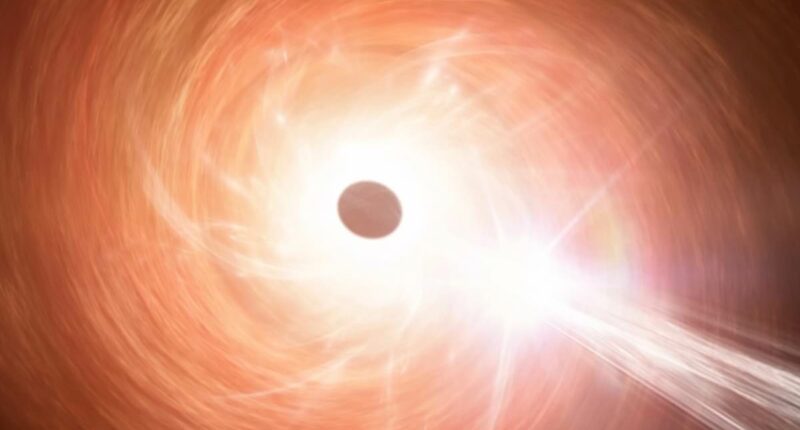Share this @internewscast.com
Black holes are among the most feared objects in the universe.
These huge concentrations of tightly–packed matter, with a gravitational pull too strong for light to escape, can gobble up entire planets.
And according to scientists, one black hole in particular seems to have an unstoppable appetite.
Located 12.8 billion light–years away, the black hole, called RACS J0320–35, weighs about a billion times the mass of our sun.
Data from NASA‘s Chandra X–ray Observatory reveals it is growing at 2.4 times the theoretical limit – one of the fastest rates ever recorded.
The power source of this ‘glowing monster’ is large amounts of matter, such as gas, dust, and other stellar debris.
As it is rabidly consumed, the matter gives off intense radiation, which is detectable by telescopes such as Chandra.
‘It was a bit shocking to see this black hole growing by leaps and bounds,’ said Luca Ighina, study author at the Harvard–Smithsonian Center for Astrophysics in Cambridge, Massachusetts.

An artist’s concept of a supermassive black hole, a surrounding disk of material falling towards the black hole, and a jet containing particles moving away at close to the speed of light. New Chandra observations indicate that the black hole is growing at a rate that exceeds the usual limit for black holes, called the Eddington Limit.
Black holes grow by gobbling up surrounding matter – a process scientists call accretion – as well as by merging with other black holes.
They have an incredibly bright ‘accretion disk’ – a hot disk of gas orbiting the black hole and its main source of light.
The accretion disk is created by material emitting energy as it falls into the black hole, whether it’s gas, dust or matter.
At about a billion times the mass of our sun, this black hole, RACS J0320–35, is officially in the upper range of the ‘supermassive’ classification for black holes – and it’s still growing.
Researchers theorize it is getting yet more massive at a rate of somewhere between 300 and 3,000 solar masses annually.
That means it’s gobbling up the equivalent of 300 to 3,000 of our suns per year!
Supermassive black holes exist in the centers of most large galaxies.
For example, Sagittarius A* is the black hole at the centre of our Milky Way galaxy, but its mass is only about 4.3 million times the mass of our sun.

Black hole RACS J0320–35, captured through X–ray emissions detected by Chandra, weighs about a billion times the mass of our sun

Annotated black hole: Right at the centre is the event horizon – the point at which nothing, not even light, can escape. Note the accretion disk’ – a hot disk of gas orbiting the black hole and its main source of light.
But what sets RACS J0320–35 apart is its high mass and unusually high growth rate.
RACS J0320–35 was discovered two years ago using NASA’s Chandra X–ray Observatory, the world’s most powerful X–ray telescope.
In orbit around Earth for more than 25 years now, Chandra is specially designed to detect X–ray emission from very hot regions of the universe.
Now, using data from the NASA telescope, researchers have been able to pinpoint the black hole’s incredible growth rate.
It is growing at 2.4 times the Eddington limit – the theoretical maximum ‘speed limit’ that defines how fast a black hole can consume matter.
The Eddington limit is the point where the outward force of radiation overcomes the inward pull of gravity – the same gravity that’s hoovering up surrounding matter.
According to the accepted theory, above this limit, all material falling into the black hole would be blown away because of the radiation pressure, shutting off the accretion that is feeding the black hole.
So the fact it is still growing – at 2.4 times the Eddington limit – is leaving scientists perplexed.

Artist rendering of the Chandra X–ray Observatory space telescope, the world’s most powerful X–ray telescope, according to NASA

Scientists lifted the veil on the first images ever captured of a black hole in April 2019. The glowing orange ring shows the event horizon of M87, in the Virgo galaxy cluster
Remarkably, RACS J0320–35 is producing more X–rays than any other black hole seen in the first billion years of the universe, they say in their paper, published in The Astrophysical Journal Letters.
The fact this black hole is located about 12.8 billion light–years from Earth means that its light has taken 12.8 billion years to get to us.
Because the universe is 13.8 billion years old, astronomers are seeing this black hole only 920 million years after the universe began.
Black holes are so far away that getting an image of one was only managed in 2019, using a massive network of Earth telescopes.
However, we have a very good chance of seeing a black hole explosion by 2035.
Another team of scientists recently reported there’s a 90 per cent chance of at least one black hole exploding in the next 10 years.
If and when it happens, telescopes positioned in space and here on Earth should be able to capture the event.
















